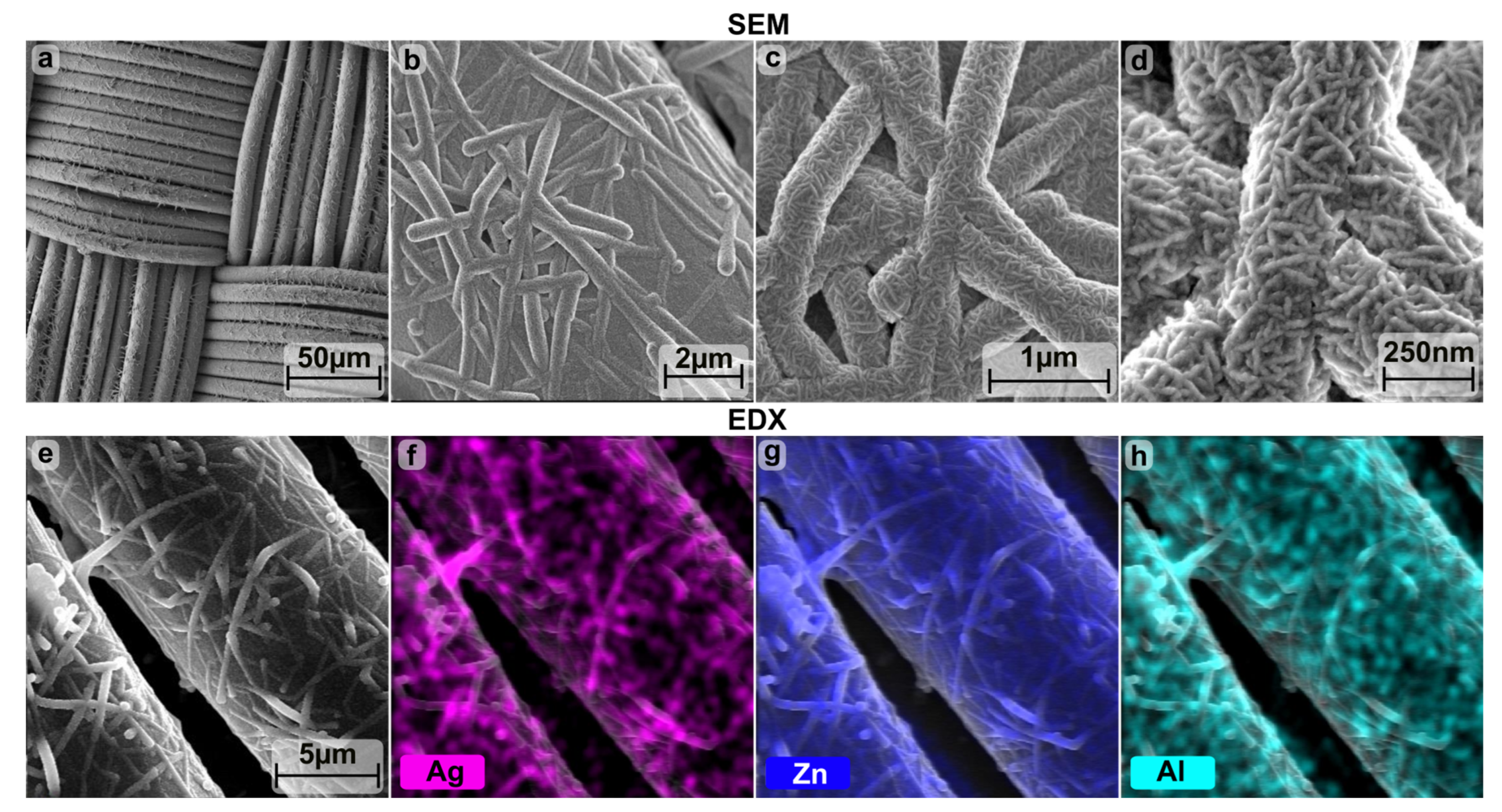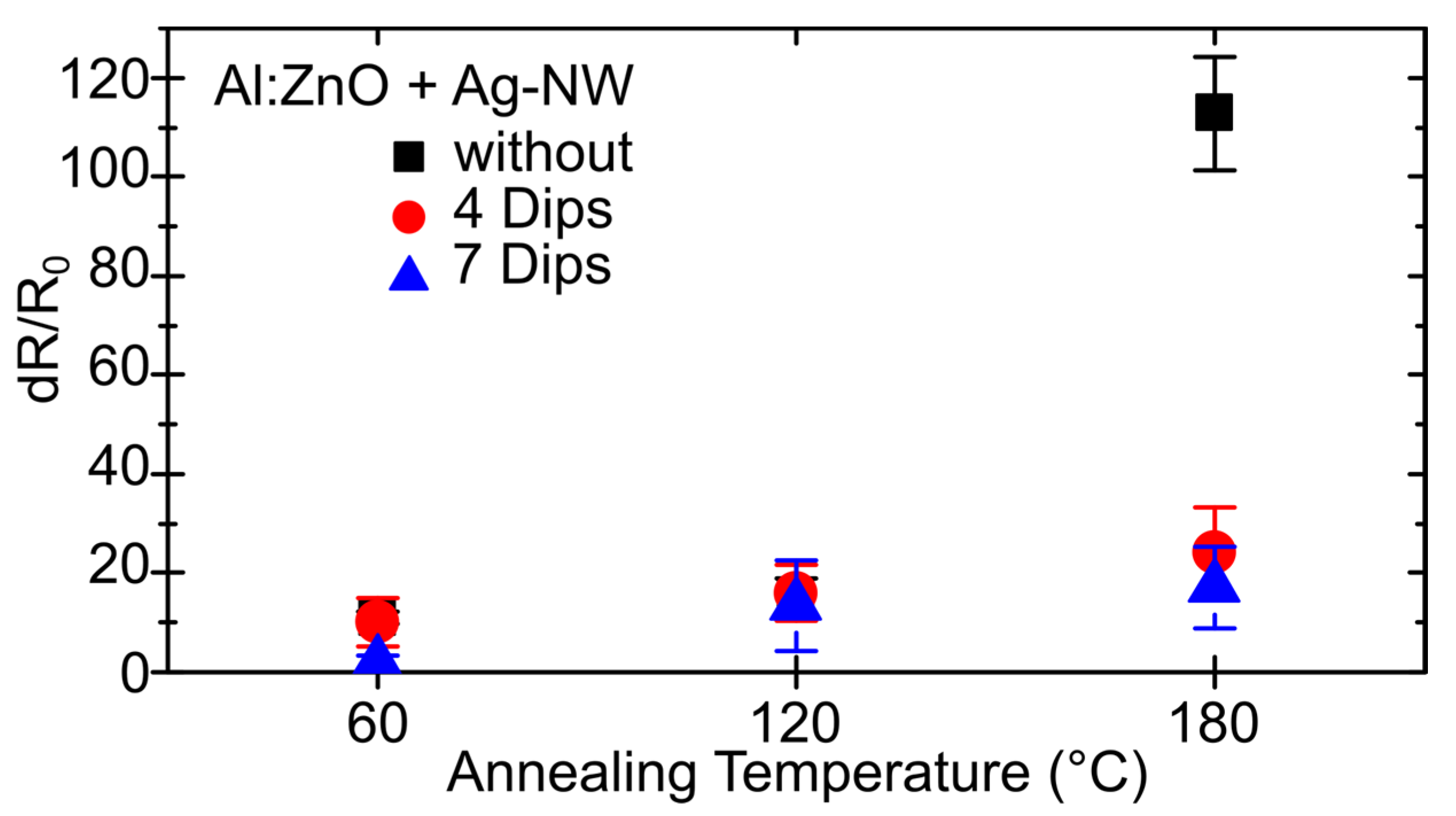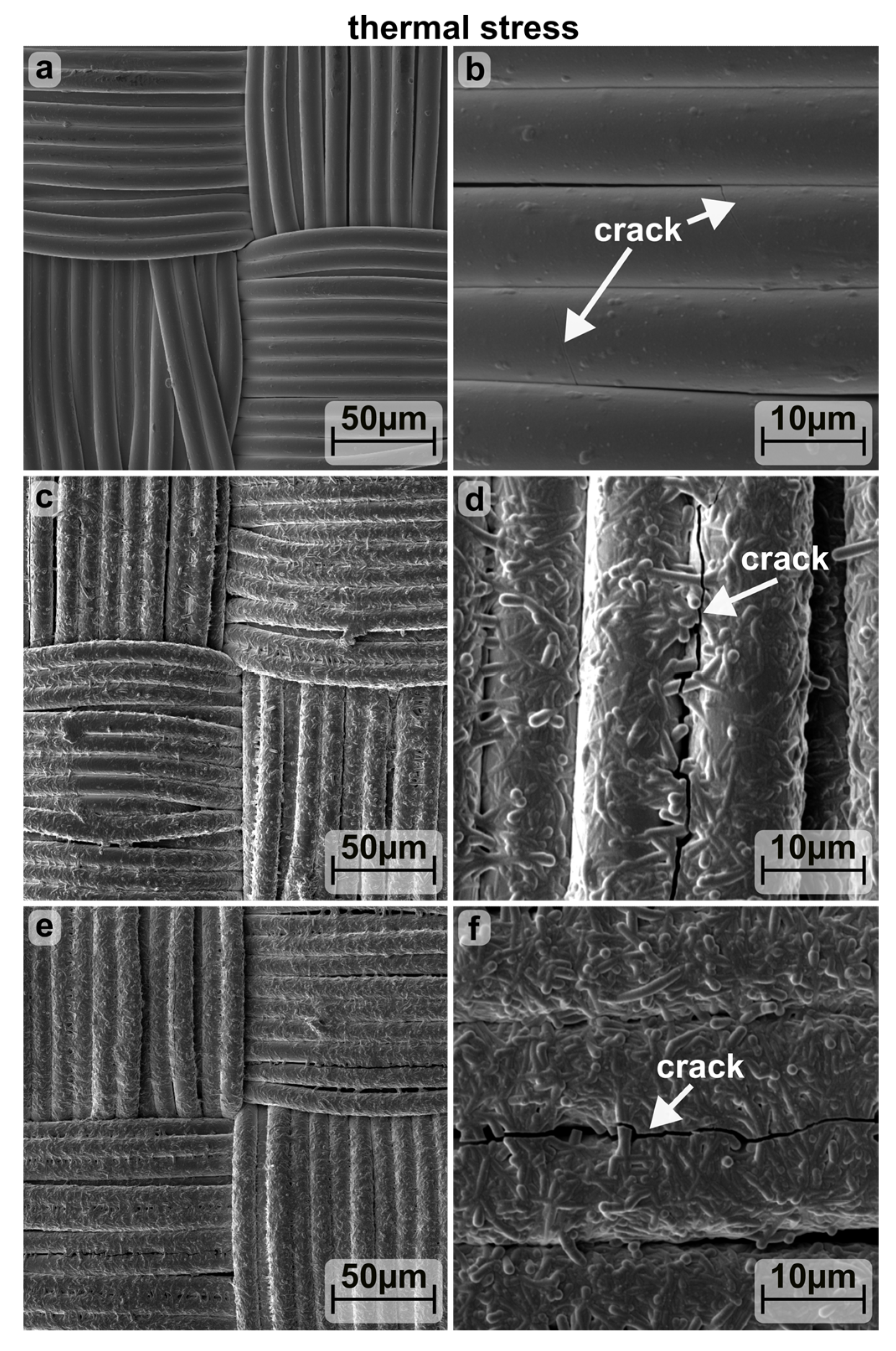Aluminum-Doped Zinc Oxide Improved by Silver Nanowires for Flexible, Semitransparent and Conductive Electrodes on Textile with High Temperature Stability
Abstract
1. Introduction
2. Materials and Methods
2.1. Cleaning Procedure
2.2. Material Deposition
2.3. Mechanical and Thermal Test
2.4. Electrical Characterization
2.5. Optical Characterization
2.6. Surface and Chemical Characterization
3. Results and Discussion
4. Conclusions
Supplementary Materials
Author Contributions
Funding
Institutional Review Board Statement
Informed Consent Statement
Data Availability Statement
Acknowledgments
Conflicts of Interest
References
- Farooq, A.S.; Zhang, P. A comprehensive review on the prospects of next-generation wearable electronics for individualized health monitoring, assistive robotics, and communication. Sens. Actuators A Phys. 2022, 344, 113715. [Google Scholar] [CrossRef]
- Kan, C.W.; Lam, Y.L. Future Trend in Wearable Electronics in the Textile Industry. Appl. Sci. 2021, 11, 3914. [Google Scholar] [CrossRef]
- Wang, L.; Fu, X.; He, J.; Shi, X.; Chen, T.; Chen, P.; Wang, B.; Peng, H. Application Challenges in Fiber and Textile Electronics. Adv. Mater. 2020, 32, e1901971. [Google Scholar] [CrossRef] [PubMed]
- Huang, L.; Lin, S.; Xu, Z.; Zhou, H.; Duan, J.; Hu, B.; Zhou, J. Fiber-Based Energy Conversion Devices for Human-Body Energy Harvesting. Adv. Mater. 2020, 32, e1902034. [Google Scholar] [CrossRef] [PubMed]
- Schmidl, G.; Jia, G.; Gawlik, A.; Andra, G.; Richter, K.; Plentz, J. Aluminum-doped zinc oxide-coated 3D spacer fabrics with electroless plated copper contacts for textile thermoelectric generators. Mater. Today Energy 2021, 21, 100811. [Google Scholar] [CrossRef]
- Ojstrsek, A.; Plohl, O.; Gorgieva, S.; Kurecic, M.; Jancic, U.; Hribernik, S.; Fakin, D. Metallisation of Textiles and Protection of Conductive Layers: An Overview of Application Techniques. Sensors 2021, 21, 3508. [Google Scholar] [CrossRef]
- Moraes, M.R.; Alves, A.C.; Toptan, F.; Martins, M.S.; Vieira, E.M.F.; Paleo, A.J.; Souto, A.P.; Santos, W.L.F.; Esteves, M.F.; Zille, A. Glycerol/PEDOT: PSS coated woven fabric as a flexible heating element on textiles. J. Mater. Chem. C 2017, 5, 3807–3822. [Google Scholar] [CrossRef]
- Jangra, V.; Maity, S.; Vishnoi, P. A review on the development of conjugated polymer-based textile thermoelectric generator. J. Ind. Text. 2021, 51 (Suppl. S1), 181S–214S. [Google Scholar] [CrossRef]
- Yin, Z.; Lu, H.; Gan, L.; Zhang, Y. Electronic Fibers/Textiles for Health-Monitoring: Fabrication and Application. Adv. Mater. Technol. 2022, 8, 2200654. [Google Scholar] [CrossRef]
- Amini, M.; Nasouri, K.; Askari, G.; Shanbeh, M.; Khoddami, A. Lightweight and Highly Flexible Metal Deposited Composite Fabrics for High-performance Electromagnetic Interference Shielding at Gigahertz Frequency. Fibers Polym. 2022, 23, 800–806. [Google Scholar] [CrossRef]
- Jia, G.; Plentz, J.; Dellith, A.; Schmidt, C.; Dellith, J.; Schmidl, G.; Andra, G. Biomimic Vein-Like Transparent Conducting Electrodes with Low Sheet Resistance and Metal Consumption. Nano Micro Lett. 2020, 12, 19. [Google Scholar] [CrossRef] [PubMed]
- Chang, W.; Nam, D.; Lee, S.; Ko, Y.; Kwon, C.H.; Ko, Y.; Cho, J. Fibril-Type Textile Electrodes Enabling Extremely High Areal Capacity through Pseudocapacitive Electroplating onto Chalcogenide Nanoparticle-Encapsulated Fibrils. Adv. Sci. 2022, 9, 2203800. [Google Scholar] [CrossRef] [PubMed]
- Maheshwari, N.; Abd-Ellah, M.; Goldthorpe, I.A. Transfer printing of silver nanowire conductive ink for e-textile applications. Flex. Print. Electron. 2019, 4, 025005. [Google Scholar] [CrossRef]
- Ko, K.-J.; Lee, H.B.; Kang, J.-W. Flexible, Wearable Organic Light-Emitting Fibers Based on PEDOT:PSS/Ag-Fiber Embedded Hybrid Electrodes for Large-Area Textile Lighting. Adv. Mater. Technol. 2020, 5, 2000168. [Google Scholar] [CrossRef]
- Ryan, J.D.; Mengistie, D.A.; Gabrielsson, R.; Lund, A.; Muller, C. Machine-Washable PEDOT:PSS Dyed Silk Yarns for Electronic Textiles. ACS Appl. Mater. Interfaces 2017, 9, 9045–9050. [Google Scholar] [CrossRef] [PubMed]
- Liu, X.; Du, X.; Li, L.; Cao, Y.; Yang, Y.; Wang, W.; Wang, J. Multifunctional AgNW@MXene decorated polymeric textile for highly-efficient electro-/photothermal conversion and triboelectric nanogenerator. Compos. Part A Appl. Sci. Manuf. 2022, 156, 106883. [Google Scholar] [CrossRef]
- Plentz, J.; Andra, G.; Pliewischkies, T.; Bruckner, U.; Eisenhawer, B.; Falk, F. Amorphous silicon thin-film solar cells on glass fiber textiles. Mater. Sci. Eng. B-Adv. Funct. Solid-State Mater. 2016, 204, 34–37. [Google Scholar] [CrossRef]
- Luka, G.; Witkowski, B.S.; Wachnicki, L.; Jakiela, R.; Virt, I.S.; Andrzejczuk, M.; Lewandowska, M.; Godlewski, M. Electrical and mechanical stability of aluminum-doped ZnO films grown on flexible substrates by atomic layer deposition. Mater. Sci. Eng. B. 2014, 186, 15–20. [Google Scholar] [CrossRef]
- Zhang, Y.H.; Mei, Z.X.; Liang, H.L.; Du, X.L. Review of flexible and transparent thin-film transistors based on zinc oxide and related materials. Chin. Phys. B 2017, 26, 047307. [Google Scholar] [CrossRef]
- Kumar, A.; Kumar, M.; Goyat, M.S.; Avasthi, D.K. A review of the latest developments in the production and applications of Ag-nanowires as transparent electrodes. Mater. Today Commun. 2022, 33, 104433. [Google Scholar] [CrossRef]
- Zhou, W.; Yao, S.; Wang, H.; Du, Q.; Ma, Y.; Zhu, Y. Gas-Permeable, Ultrathin, Stretchable Epidermal Electronics with Porous Electrodes. ACS Nano 2020, 14, 5798–5805. [Google Scholar] [CrossRef] [PubMed]
- Teymouri, A.; Pillai, S.; Ouyang, Z.; Hao, X.; Liu, F.; Yan, C.; Green, M.A. Low-Temperature Solution Processed Random Silver Nanowire as a Promising Replacement for Indium Tin Oxide. ACS Appl. Mater. Interfaces 2017, 9, 34093–34100. [Google Scholar] [CrossRef] [PubMed]
- Peng, S.; Yu, Y.; Wu, S.; Wang, C.-H. Conductive Polymer Nanocomposites for Stretchable Electronics: Material Selection, Design, and Applications. ACS Appl. Mater. Interfaces 2021, 13, 43831–43854. [Google Scholar] [CrossRef] [PubMed]
- Sohn, H.; Park, C.; Oh, J.-M.; Kang, S.W.; Kim, M.-J. Silver Nanowire Networks: Mechano-Electric Properties and Applications. Materials 2019, 12, 2526. [Google Scholar] [CrossRef] [PubMed]
- Arat, R.; Jia, G.; Plentz, J. Wet chemical method for highly flexible and conductive fabrics for smart textile applications. J. Text. Inst. 2022, 114, 639–644. [Google Scholar] [CrossRef]
- Liu, J.; Xu, M.Z.; Li, J.H.; Zhang, T.S.; Chu, X.Y.; Jin, F.J.; Zhai, Y.J.; Shi, K.X.; Lu, D.X. Solution synthesis of Al:ZnO-AgNWs-Al:ZnO flexible transparent conductive film. J. Mater. Sci. Mater. Electron. 2020, 31, 4178–4183. [Google Scholar] [CrossRef]
- Gao, S.L.; Zhao, X.H.; Fu, Q.; Zhang, T.C.; Zhu, J.; Hou, F.H.; Ni, J.; Zhu, C.J.; Li, T.T.; Wang, Y.L.; et al. Highly transmitted silver nanowires-SWCNTs conductive flexible film by nested density structure and aluminum-doped zinc oxide capping layer for flexible amorphous silicon solar cells. J. Mater. Sci. Technol. 2022, 126, 152–160. [Google Scholar] [CrossRef]
- Bin, P.S.; Geng, W.H.; Wang, T.; Zhu, Q.X.; Li, M.; Liu, X.L.; Qian, P.F.; Bao, Z.L.; Yang, Z.X.; Geng, H.Z. Aluminum-Doped ZnO Weld Silver Nanowires-Based High Transmittance, Low Sheet Resistance, and Tough Composite Transparent Conductive Films. Adv. Eng. Mater. 2022, 25, 2201444. [Google Scholar] [CrossRef]
- Neto, J.P.; Costa, A.; Pinto, J.V.; Marques-Smith, A.; Costa, J.C.; Martins, R.; Fortunato, E.; Kampff, A.R.; Barquinha, P. Transparent and Flexible Electrocorticography Electrode Arrays Based on Silver Nanowire Networks for Neural Recordings. Acs Appl. Nano Mater. 2021, 4, 5737–5747. [Google Scholar] [CrossRef]
- Huang, Q.; Shen, W.; Fang, X.; Chen, G.; Yang, Y.; Huang, J.; Tan, R.; Song, W. Highly thermostable, flexible, transparent, and conductive films on polyimide substrate with an AZO/AgNW/AZO structure. ACS Appl. Mater. Interfaces 2015, 7, 4299–4305. [Google Scholar] [CrossRef]
- Yang, C.; Merlo, J.M.; D’Imperio, L.A.; Rose, A.H.; Calm, Y.M.; Han, B.; Gao, J.; Zhou, G.; Burns, M.J.; Kempa, K.; et al. All-Solution-Processed Micro/Nanowires with Electroplate Welding as Transparent Conducting Electrodes. Phys. Status Solidi (RRL) Rapid Res. Lett. 2019, 13, 1900010. [Google Scholar] [CrossRef]
- Yang, Q.; Wang, X.; Ding, X.; Li, Q. Fabrication and Characterization of Wrapped Metal Yarns-based Fabric Temperature Sensors. Polymers 2019, 11, 1549. [Google Scholar] [CrossRef] [PubMed]









| Number of Dip Coating Cycles | Sheet Resistance of Ag-NW Coating (Ω/sq) | Sheet Resistance of Ag-NW + Al:ZnO Coating (Ω/sq) |
|---|---|---|
| 0 | ∞ | 39.7 ± 4.2 |
| 4 | 576 ± 302 | 21.1 ± 2.6 |
| 7 | 24.7 ± 4.5 | 10.2 ± 2.2 |
| ∞ | 19.3 ± 0.5 | / |
| Condition | dLPA (µm) | dLAl:ZnO (µm) | dL (µm) | |
|---|---|---|---|---|
| Beding: | φ = 210° | 26.0 | 1.9 | 24.1 |
| Thermal: | T = 60 °C | 80.0 | 2.9 | 77.1 |
| T = 120 °C | 200 | 7.3 | 192 | |
| T = 180 °C | 320 | 11.6 | 308 |
Disclaimer/Publisher’s Note: The statements, opinions and data contained in all publications are solely those of the individual author(s) and contributor(s) and not of MDPI and/or the editor(s). MDPI and/or the editor(s) disclaim responsibility for any injury to people or property resulting from any ideas, methods, instructions or products referred to in the content. |
© 2023 by the authors. Licensee MDPI, Basel, Switzerland. This article is an open access article distributed under the terms and conditions of the Creative Commons Attribution (CC BY) license (https://creativecommons.org/licenses/by/4.0/).
Share and Cite
Hupfer, M.L.; Gawlik, A.; Dellith, J.; Plentz, J. Aluminum-Doped Zinc Oxide Improved by Silver Nanowires for Flexible, Semitransparent and Conductive Electrodes on Textile with High Temperature Stability. Materials 2023, 16, 3961. https://doi.org/10.3390/ma16113961
Hupfer ML, Gawlik A, Dellith J, Plentz J. Aluminum-Doped Zinc Oxide Improved by Silver Nanowires for Flexible, Semitransparent and Conductive Electrodes on Textile with High Temperature Stability. Materials. 2023; 16(11):3961. https://doi.org/10.3390/ma16113961
Chicago/Turabian StyleHupfer, Maximilian Lutz, Annett Gawlik, Jan Dellith, and Jonathan Plentz. 2023. "Aluminum-Doped Zinc Oxide Improved by Silver Nanowires for Flexible, Semitransparent and Conductive Electrodes on Textile with High Temperature Stability" Materials 16, no. 11: 3961. https://doi.org/10.3390/ma16113961
APA StyleHupfer, M. L., Gawlik, A., Dellith, J., & Plentz, J. (2023). Aluminum-Doped Zinc Oxide Improved by Silver Nanowires for Flexible, Semitransparent and Conductive Electrodes on Textile with High Temperature Stability. Materials, 16(11), 3961. https://doi.org/10.3390/ma16113961







